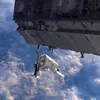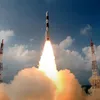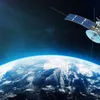Here's all you need to know about Chandrayaan-2 and why ISRO wants to explore the dark side of the moon
ISRO gears up to launch India’s second moon mission, Chandrayaan-2, at 2.51 am tomorrow from the spaceport in Sriharikota. The spacecraft aims at going where no other nation has so far forayed - the lunar south pole - to improve the world’s understanding of the moon.
Aimed at taking a giant leap in its space programme, the Indian Space Research Organisation (ISRO) will in the early hours of Monday launch its second moon mission, Chandrayaan-2, on-board its heavy-lift rocket GSLV-MkIII, nicknamed Baahubali, from the spaceport in Sriharikota, Andhra Pradesh, to land a rover near the unexplored Lunar Southern Pole.
The lift-off of the three-component spacecraft, weighing 3,850 kg and comprising an orbiter, the lander, and the rover, is scheduled for 2.51 am from the Satish Dhawan Space Centre (SDSC).
Eleven years after its successful first lunar mission, the ISRO will launch the Rs 978 crore Chandrayaan-2 on-board Geosynchronous Launch Vehicle GSLV-MkIII on a voyage, which will then take 54 days to accomplish the task of landing on the moon through meticulously planned orbital phases.
_(1)1563090042409.jpg?fm=png&auto=format)
The Geosynchronous Satellite Launch Vehicle Mark III, nicknamed Baahubali, is seen at the second launch pad ahead of the launch of Chandrayaan-2. ISRO's latest space mission aims to land a robotic rover on the moon (Image: PTI).
After a full dress rehearsal last week, the countdown for the mission commenced Sunday and scientists were involved in propellant filling, ISRO officials said.
“The launch countdown of GSLV-MkIII-M1/Chandrayaan-2 commenced today (Sunday) at 0651 hrs IST,” ISRO said in its latest update.
Billed as the most complex and prestigious mission ever undertaken by the ISRO since its inception, Chandrayaan-2 will make India the fourth country to soft land on the lunar surface after Russia, the US, and China.
Indicating the challenges involved in soft landing, which will feature a series of critical manoeuvres by scientists, ISRO Chairman K Sivan said they would undergo about “15 minutes of terror (filled moments)”.
The next leap in technology
After offering prayers at the hill shrine of Lord Venkateshwara at Tirumala Saturday, Sivan said all preparations for Chandrayaan-2 were on for the launch scheduled at 2.51 am on July 15. President Ram Nath Kovind will witness the launch at Sriharikota.
“Chandrayaan-2 is the next leap in technology as we attempt to soft land close to the south pole of the moon. The soft landing is extremely complex and we will experience approximately 15 minutes of terror," he said
ISRO, which has planned for the landing around September 6, said the mission aimed at going where no other nation has so far forayed - the lunar south pole - and sought to improve the understanding of the moon, which could lead to discoveries that will benefit India and humanity as a whole.
The Chandrayaan-2 has 13 payloads in total with eight of them in the orbiter, three payloads in Vikram, and two in Pragyan. Five payloads are from India, three from Europe, two from the US, and one from Bulgaria. A Laser Retroreflector Array (LRA) of NASA is among the payloads and is aimed at understanding the dynamics of earth's moon system and deriving clues on the lunar interior.
About 16 minutes after lift-off, the GSLV MkIII will inject Chandrayaan-2 into 170 x 40400 km earth orbit.
From then, the mission will witness a series of manoeuvres by scientists to carry out different phases. For the first 17 days from lift-off, the spacecraft will be in its earth-bound phase before its orbit is finally raised to over 1.05 lakh km.
After that, it will be nudged into the lunar transfer trajectory, taking it to the proximity of the moon in the next two days. Over the next few days, it will gradually be brought to 100X100 km circular orbit when the lander will separate. After another few days of orbiting, it will make a soft landing at a chosen place on the lunar surface.
Through Chandrayaan-2, in which homegrown technology is deployed, scientists aim to expand India's footprint in space, shed light on an unexplored section of the moon (the south pole region), enhance knowledge about space, stimulate advancement of technology, and promote global alliances.
It is ISRO’s first attempt at a soft landing on the lunar surface equipped with homegrown technology. It would also be the first mission to explore the lunar terrain.
Why the south polar region of the moon?
According to ISRO, the lunar south pole is an interesting surface area, which remains in shadow as compared to the north pole. There is a possibility of the presence of water in permanently shadowed areas around it, the agency said, adding craters in the south pole region have cold traps and contain fossil records of the early solar system.
The lander Vikram, named after father of Indian space research programme Dr Vikram A Sarabhai, carrying the rover Pragyan, will be landed in a high plain between two craters at a latitude of about 70 degree south of the moon.
The 27-kg Pragyan, meaning “wisdom” in Sanskrit and a six-wheeled robotic vehicle, will then set out on its job of collecting information on the lunar surface.
The rover can travel up to half a km, leveraging solar energy, and both Pragyan and Vikram have a mission life of one lunar day, which approximately equals 14 earth days.
The challenges along the way
ISRO officials said the challenges involved in the moon landing were identifying trajectory accurately; taking up deep space communication; trans-lunar injection, orbiting around the moon, taking up soft landing on the moon surface, and facing extreme temperatures and vacuum.
Scientists have pegged to make the landing of lander Vikram on September 6, and then undertake a series of complex manoeuvres comprising "rough braking" and "fine braking".
A safe site free of hazards would be decided for landing based on pictures sent back by the camera on-board the lander. After touchdown, the rover will carry out experiments for 14 earth days.
(Edited by Teja Lele Desai)











